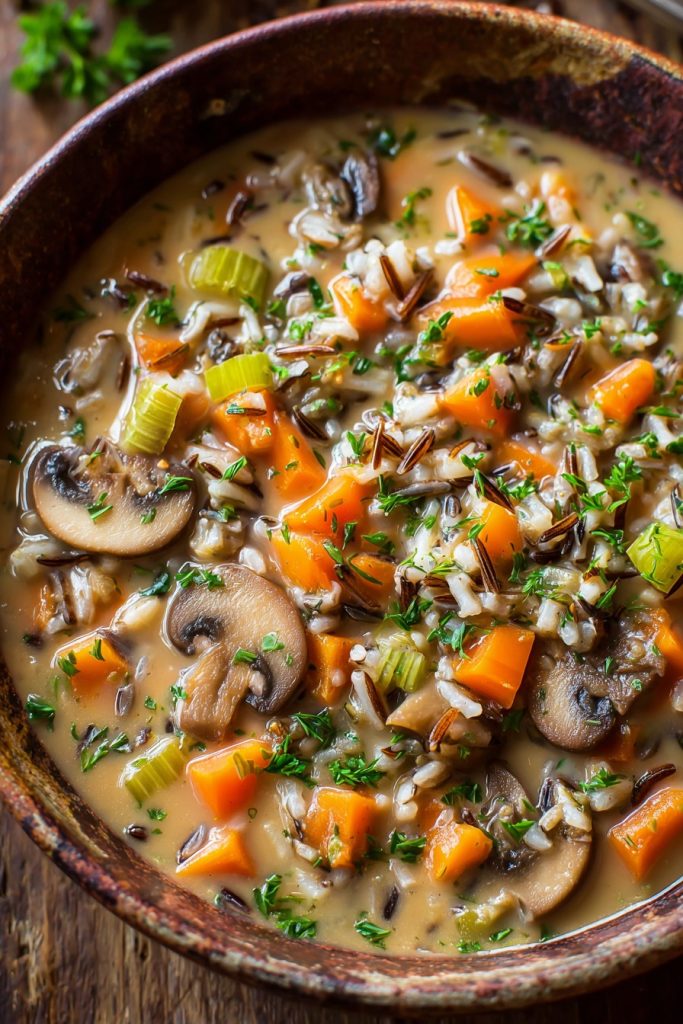Elevating humble ingredients through precise technique transforms this wild rice soup into culinary excellence. Every element, from the nutty grain to the aromatic foundation, receives meticulous attention to create layers of flavor and texture that distinguish this recipe from ordinary preparations. Expect a masterclass in building complexity through controlled cooking processes.
Why This Recipe Works
- The dual-cooking method for wild rice—initial simmering followed by gentle finishing in the soup—ensures perfect texture without compromising the broth’s clarity or flavor integrity.
- Building a proper fond by searing mushrooms and vegetables creates deep umami notes that form the foundation of the soup’s complex flavor profile.
- Incorporating a roux-based thickening technique provides superior mouthfeel and stability compared to starch-thickened versions, allowing flavors to develop fully during simmering.
- Strategic layering of fresh herbs—adding hardy varieties early and delicate ones at finish—maximizes aromatic impact while maintaining visual appeal and fresh flavor notes.
- Finishing with a touch of cream and acid balances richness while brightening the overall flavor composition, creating a perfectly rounded final product.
Ingredients
- 1 cup wild rice, rinsed and drained
- 4 cups chicken stock, divided
- 4 tablespoons unsalted butter
- 1 large yellow onion, finely diced
- 2 medium carrots, peeled and cut into ¼-inch dice
- 2 celery stalks, cut into ¼-inch dice
- 8 ounces cremini mushrooms, sliced ¼-inch thick
- 3 cloves garlic, minced
- ¼ cup all-purpose flour
- 1 teaspoon fresh thyme leaves
- 1 bay leaf
- 1 cup heavy cream
- 2 tablespoons dry sherry
- 1 teaspoon lemon juice
- ½ cup chopped fresh parsley
- Salt and freshly ground black pepper to taste
Equipment Needed
- Large heavy-bottomed Dutch oven or soup pot
- Medium saucepan with lid
- Wooden spoon or spatula
- Chef’s knife
- Cutting board
- Measuring cups and spoons
- Ladle
- Fine-mesh strainer
Instructions

Prepare the Wild Rice
Begin by cooking the wild rice separately to achieve optimal texture and prevent clouding the final soup. Combine 1 cup rinsed wild rice with 3 cups chicken stock in a medium saucepan. Bring to a boil over high heat, then reduce to a bare simmer, cover, and cook for 45 minutes. The rice should be tender but still chewy with some grains split open. Drain any excess liquid and set aside. This preliminary cooking allows the rice to absorb maximum flavor while maintaining structural integrity when added to the soup later. Properly cooked wild rice will have expanded to approximately 3-4 cups and display a mix of split and intact grains with a pleasant nutty aroma.
Build the Aromatic Base
Melt 4 tablespoons unsalted butter in a large Dutch oven over medium heat until foaming subsides. Add 1 finely diced yellow onion, 2 diced carrots, and 2 diced celery stalks. Cook, stirring frequently, for 8-10 minutes until vegetables have softened and developed slight caramelization at the edges. The onions should become translucent while maintaining some texture. Add 8 ounces sliced cremini mushrooms and continue cooking for another 6-8 minutes until mushrooms have released their moisture and developed golden-brown coloration. Stir in 3 minced garlic cloves and cook for 1 minute until fragrant but not browned. This foundational step creates the flavor backbone through proper Maillard reactions and vegetable sweetness development.
Create the Roux and Thicken
Sprinkle ¼ cup all-purpose flour over the vegetable mixture and cook, stirring constantly, for 2-3 minutes until the raw flour aroma dissipates and the mixture turns pale golden. The flour should coat all vegetables evenly and form a paste-like consistency. Gradually whisk in the remaining 1 cup chicken stock, ensuring no lumps form. The mixture will thicken immediately. Continue whisking until smooth, then add the cooked wild rice, 1 teaspoon fresh thyme leaves, and 1 bay leaf. Bring to a gentle simmer, stirring occasionally to prevent sticking. The roux-based thickening provides superior emulsion stability compared to cornstarch or arrowroot.
Develop Flavor Through Simmering
Reduce heat to maintain a bare simmer—small bubbles should break the surface occasionally but not vigorously. Cover partially and cook for 20 minutes, stirring every 5 minutes to prevent scorching. During this stage, the flour will fully hydrate and lose its raw taste while the rice continues to absorb flavors. The soup should thicken to a creamy consistency that coats the back of a spoon. Taste and adjust seasoning with salt and pepper, remembering the cream will dilute saltiness slightly. This gentle simmering allows flavors to meld while maintaining vegetable texture integrity.
Finish with Cream and Herbs
Remove the soup from heat and discard the bay leaf. Stir in 1 cup heavy cream, 2 tablespoons dry sherry, and 1 teaspoon lemon juice. The acid from lemon and sherry will brighten the rich flavors while balancing the cream’s richness. Return to very low heat just to warm through—do not boil after adding cream to prevent curdling. Stir in ½ cup chopped fresh parsley just before serving. The final temperature should reach 160°F to ensure food safety while preserving the fresh herb flavors. Serve immediately in pre-warmed bowls for optimal temperature maintenance.
Tips and Tricks
For exceptional wild rice texture, consider soaking the grains in cold water for 30 minutes before cooking to reduce cooking time and ensure more even doneness. When building your aromatic base, pay close attention to the mushroom searing process—allow adequate space between slices to promote proper browning rather than steaming. If your soup becomes too thick during simmering, thin with additional warm stock rather than water to maintain flavor intensity. For a vegetarian version, substitute vegetable stock and consider adding 1 tablespoon white miso paste during the final seasoning stage to replicate the umami depth of chicken stock. When making the roux, if it appears too dry or clumpy, add an additional tablespoon of butter to achieve proper paste consistency before adding liquid. For advanced flavor development, consider roasting the wild rice in a dry skillet for 3-4 minutes before cooking to enhance its nutty characteristics. If preparing ahead, cool the soup rapidly by transferring to a shallow metal pan and refrigerating uncovered for 30 minutes before covering—this prevents bacterial growth and maintains quality. When reheating, do so gently over low heat while stirring frequently to prevent separation of the cream emulsion. For restaurant-style presentation, reserve some cooked wild rice and fresh herbs to garnish each bowl just before serving, creating visual texture contrast. If your soup appears oily on the surface, carefully blot with paper towels or use a fat separator when transferring between containers.
Recipe Variations
- For a heartier protein-forward version, add 2 cups shredded cooked chicken or turkey during the final simmering stage. The poultry will absorb the soup’s flavors while contributing additional substance. Consider using roasted or smoked poultry for deeper flavor complexity.
- Transform into a creamy mushroom and wild rice soup by doubling the mushroom quantity and incorporating 1 ounce dried porcini mushrooms. Rehydrate the porcinis in warm water, strain the liquid through cheesecloth, and use this flavorful liquid to replace part of the stock.
- Create a Minnesota-style wild rice soup by adding 1 cup cooked and crumbled breakfast sausage along with ½ cup frozen corn kernels. The sausage provides savory notes while corn adds sweetness and texture contrast.
- For a seafood adaptation, substitute 1 pound peeled and deveined shrimp or 2 cups cooked lobster meat. Add seafood during the final heating stage just until cooked through to prevent toughness.
- Develop a vegetarian cream of wild rice soup by using vegetable stock and adding 1 cup cooked lentils or white beans for protein. Finish with a tablespoon of nutritional yeast for cheesy undertones without dairy.
Frequently Asked Questions
Can I make wild rice soup ahead of time?
Yes, this soup excels when made ahead, as flavors continue to develop during refrigeration. Prepare through the simmering stage, then cool completely before adding cream and herbs. Store covered in the refrigerator for up to 3 days. When ready to serve, reheat gently over low heat, then add the cream, sherry, lemon juice, and fresh parsley. The rice may absorb some liquid during storage, so have additional warm stock available to adjust consistency if needed. Avoid freezing cream-based soups as they may separate upon thawing.
What’s the difference between wild rice and other rice varieties?
Wild rice is actually an aquatic grass seed rather than true rice, which accounts for its distinctive chewy texture and nutty flavor profile. It contains more protein and fiber than white or brown rice and requires longer cooking times—typically 45-60 minutes compared to 15-20 for white rice. The grains split open when properly cooked, revealing a tender interior while maintaining structural integrity. Its robust character stands up well to creamy preparations and extended simmering without becoming mushy.
How can I prevent my cream-based soup from curdling?
Curdling occurs when the proteins in cream coagulate due to high heat or acid exposure. To prevent this, always add cream at the end of cooking and heat gently without boiling. The lemon juice and sherry should be incorporated simultaneously with the cream to distribute acidity evenly. If concerned about curdling, you can temper the cream by gradually adding small amounts of hot soup to the cream before combining everything. Using heavy cream (at least 36% milk fat) provides more stability than lighter cream options.
Can I use quick-cooking or instant wild rice?
While convenient, quick-cooking wild rice undergoes pre-processing that compromises texture and flavor complexity. The grains tend to become mushy and lack the characteristic chew of traditionally cooked wild rice. If substitution is necessary, reduce cooking time significantly and add during the final 10 minutes of simmering. For optimal results, stick with whole grain wild rice and allocate the necessary cooking time—the texture difference is substantial and worth the additional preparation.
What’s the purpose of cooking rice separately from the soup?
This technique serves multiple purposes: it prevents the starch from clouding the broth, allows precise control over rice doneness, and enables the rice to absorb maximum flavor from both cooking liquids. The initial cooking in plain stock ensures the rice develops its characteristic texture without competition from other ingredients. When added to the soup, it continues to absorb the complex flavors while maintaining structural integrity. This method also allows for easier consistency adjustment since the rice’s starch release is controlled.
Summary
This chef-inspired wild rice soup demonstrates how technical precision transforms simple ingredients into extraordinary comfort food. Through controlled cooking methods and flavor layering, each component contributes to a harmoniously balanced final dish that satisfies both technically and emotionally.
Wild Rice Soup
5
servings20
minutes75
minutesIngredients
Instructions
- 1 Cook wild rice with 3 cups chicken stock for 45 minutes, drain and set aside
- 2 Sauté vegetables in butter until softened and lightly caramelized
- 3 Make roux with flour, then gradually whisk in remaining stock
- 4 Add cooked rice and herbs, simmer for 20 minutes
- 5 Finish with cream, sherry, lemon juice, and parsley



